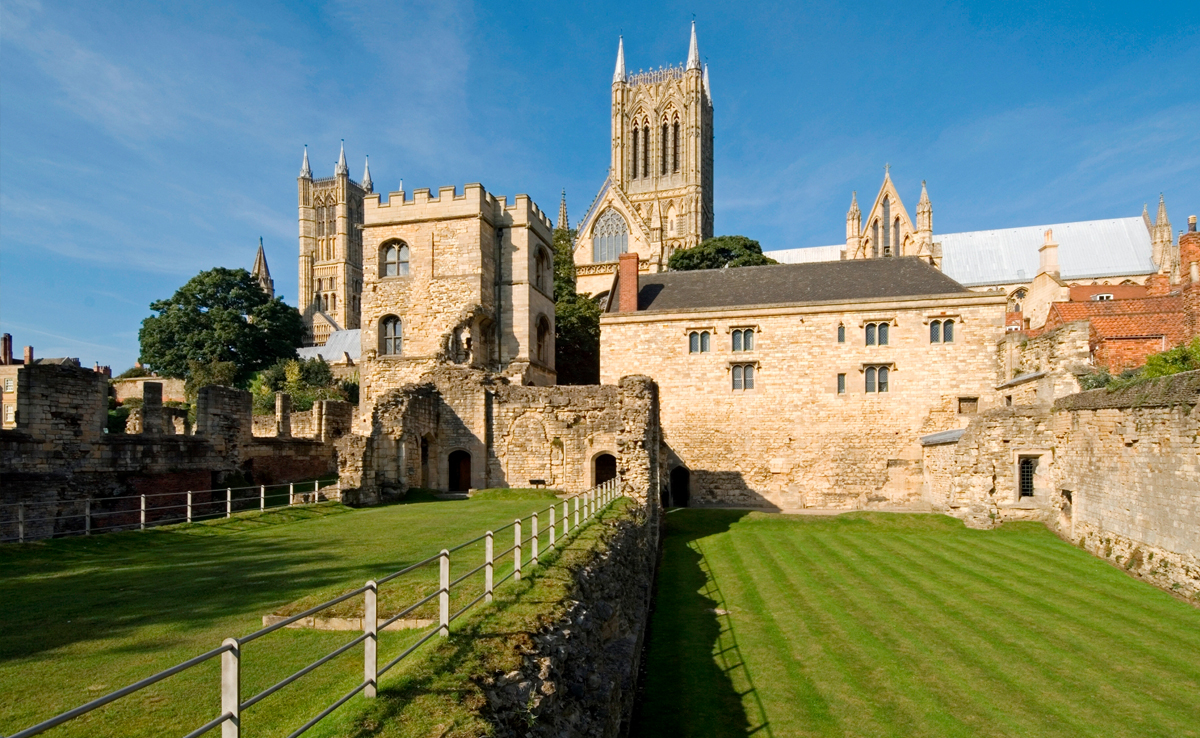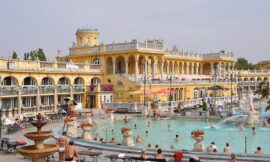Introduction
The Medieval Bishop’s Palace, located near Lincoln Cathedral in Lincoln, UK, is one of the finest examples of ecclesiastical architecture from the Middle Ages. Built in the late 12th century, the palace served as the residence and administrative center for the bishops of Lincoln, who were among the most powerful religious figures in England at the time. The palace stands as a testament to the wealth, influence, and architectural prowess of the medieval Church, reflecting the significant role that bishops played in both religious and secular affairs. Today, the Medieval Bishop’s Palace is a historic site managed by English Heritage, offering visitors a fascinating insight into the life and power of medieval bishops.
Historical Background and Construction
The Medieval Bishop’s Palace was constructed during a period of significant growth and prosperity for the Church in England. The Diocese of Lincoln was one of the largest in medieval England, extending from the River Thames to the Humber estuary. The bishops of Lincoln wielded immense power, not only as spiritual leaders but also as feudal lords and advisors to the king. This dual role required a residence that was not only functional but also impressive, serving as a symbol of their authority.
The palace was founded in the late 12th century by Bishop Hugh of Avalon, later canonized as Saint Hugh of Lincoln. Bishop Hugh was a prominent figure known for his piety, administrative skill, and efforts to reform the Church. Under his leadership, the construction of the Bishop’s Palace began, with the initial phase focusing on building the main hall, chapel, and domestic quarters. Over the centuries, successive bishops expanded and enhanced the palace, adding new buildings, gardens, and defensive features, such as walls and gatehouses.
Architectural Features
The Medieval Bishop’s Palace is an outstanding example of Norman and early Gothic architecture, characterized by its robust construction, grand halls, and intricate stonework. The design of the palace reflects the dual nature of the bishop’s role, combining elements of a fortified manor house with those of a religious and administrative center.
1. The Great Hall
The Great Hall was the heart of the palace, used for ceremonies, banquets, and official functions. This grand space, originally constructed under Bishop Hugh, was designed to impress visitors and reflect the bishop’s status. It featured large arched windows, high ceilings, and ornate stone carvings. The Great Hall was the setting for important gatherings, including meetings with nobles, clergy, and even royalty. The hall’s design emphasized both the spiritual and temporal power of the bishop, serving as a reminder of the Church’s influence over medieval society.
2. The Chapel
The palace chapel was a key feature of the complex, providing a private place of worship for the bishop and his household. The chapel was richly decorated, with stained glass windows, intricate stone carvings, and an ornate altar. It served as a symbol of the bishop’s spiritual authority and was used for daily prayers, masses, and private devotions. The architectural style of the chapel reflects the transition from the Norman to the Gothic, with pointed arches and ribbed vaulting that would later become hallmarks of Gothic church architecture.
3. Residential Quarters
The bishop’s private living quarters were located within the palace complex, providing both comfort and security. These rooms were furnished with tapestries, fine furniture, and other luxurious items befitting the bishop’s status. The residential quarters included a solar, or private living room, where the bishop could conduct business or relax away from the formalities of the Great Hall. The design of these spaces combined functionality with elegance, offering a glimpse into the daily life of a medieval bishop.
4. Gardens and Grounds
The palace was set within extensive gardens and grounds, which included orchards, fishponds, and ornamental gardens. These outdoor spaces were used for leisure, as well as for growing food and herbs for the bishop’s household. The gardens were carefully designed to reflect the beauty of God’s creation, with manicured lawns, flowerbeds, and water features. The grounds also provided space for the bishop’s guests to stroll and enjoy the tranquility of the palace surroundings.
5. Defensive Features
While primarily a residence, the Medieval Bishop’s Palace also had defensive features typical of medieval manorial estates. The palace was enclosed by a high stone wall with a fortified gatehouse, providing protection against potential attacks. These fortifications were not just practical but also symbolic, representing the bishop’s authority and the Church’s role as a protector of the community. The defensive elements of the palace highlight the often turbulent nature of medieval England, where bishops needed to safeguard their properties against both local conflicts and broader political upheavals.
The Role of the Bishops of Lincoln
The bishops of Lincoln were among the most influential churchmen in medieval England, holding significant religious, political, and economic power. As spiritual leaders, they oversaw the administration of the diocese, which included managing parishes, appointing clergy, and maintaining church doctrine. They also played a key role in the wider Church, participating in ecclesiastical councils and advising the Pope on matters of doctrine and policy.
In addition to their spiritual duties, the bishops of Lincoln were major landowners and feudal lords, with vast estates generating substantial income. This wealth enabled them to build grand residences like the Bishop’s Palace and to fund charitable works, including the construction of churches, monasteries, and hospitals. The bishops were also involved in secular governance, serving as royal advisors, judges, and diplomats. Their political influence extended to the royal court, where they could shape policy and advocate for the Church’s interests.
The power and prestige of the bishops of Lincoln were reflected in their palace, which served as a hub of activity and a symbol of their authority. The palace was not just a home but a center of administration, where the bishop’s officials managed the diocese’s affairs, collected rents, and dispensed justice. It was also a place of hospitality, where the bishop entertained guests ranging from local nobility to visiting dignitaries.
Decline and Ruin
The Medieval Bishop’s Palace flourished during the height of the medieval Church’s power, but it began to decline in the later Middle Ages. The 14th century brought a series of challenges, including political instability, economic downturns, and the Black Death, which significantly reduced the population and strained the Church’s resources. The palace suffered further during the English Reformation in the 16th century, when King Henry VIII broke from the Catholic Church and dissolved many of its institutions.
The Reformation led to the redistribution of church lands and wealth, and many of the bishop’s estates, including the palace, fell into disrepair. The palace was partially destroyed during the English Civil War in the 17th century when Royalist forces used Lincoln as a stronghold. The Parliamentarian troops besieging the city damaged the palace, leaving it in ruins. By the 18th century, the palace was abandoned, and its stones were quarried for other building projects in the city.
Preservation and Modern Significance
Today, the Medieval Bishop’s Palace is a historic site managed by English Heritage, which has undertaken efforts to preserve and interpret the ruins for visitors. The site includes the remains of the Great Hall, chapel, and other structures, along with interpretive displays that provide insight into the palace’s history and the lives of the bishops who once resided there.
Visitors to the palace can explore the ruins, walk through the gardens, and enjoy stunning views of Lincoln Cathedral and the surrounding landscape. The site serves as a poignant reminder of the medieval Church’s power and the architectural legacy it left behind. It offers a window into the past, allowing visitors to step back in time and imagine the splendor and complexity of life in a medieval bishop’s residence.
Conclusion
The Medieval Bishop’s Palace is more than just a historical ruin; it is a symbol of the Church’s profound influence on medieval society. Through its grand architecture, opulent halls, and fortified walls, the palace reflects the wealth, power, and piety of the bishops who once called it home. As a residence, administrative center, and fortress, the palace played a central role in the life of medieval Lincoln, serving as a hub of religious and secular authority.
Today, the Medieval Bishop’s Palace stands as a testament to the architectural and cultural achievements of the Middle Ages. Its preservation allows us to explore the complexities of medieval ecclesiastical power and to appreciate the enduring legacy of a time when the Church was at the heart of both spiritual and temporal life. As a historic site, the palace continues to inspire curiosity and wonder, drawing visitors from around the world to experience the grandeur and history of Lincoln’s medieval past.



